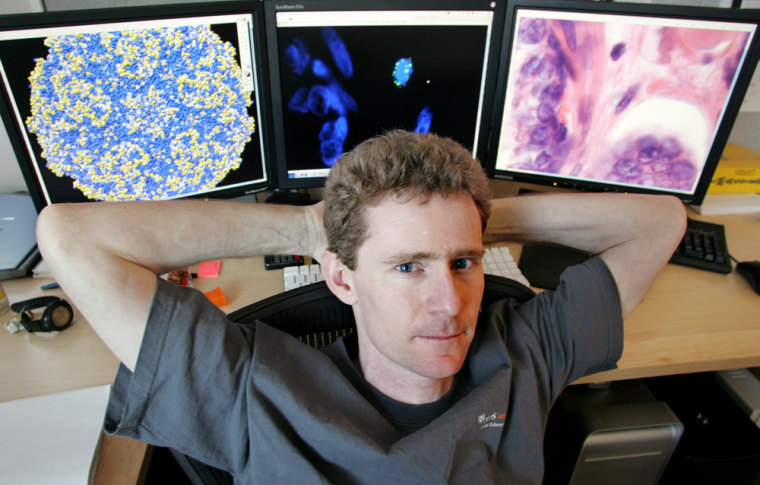In a surprising discovery, researchers said Friday they had found a virus in some prostate cancer patients, a finding that opens new research avenues in the most common major cancer among men in the United States.
The virus, closely related to one previously seen only in mice, was found in cancerous prostates removed from men with a certain genetic defect. The researchers, with the University of California, San Francisco and the Cleveland Clinic, warn that they have not discovered any links between the virus and prostate cancer, but they were nonetheless excited about prospects for future research.
“It is a very exciting discovery,” said Dr. Eric Klein of the Cleveland Clinic, who presented the findings at an American Society of Clinical Oncology meeting. “There is now a suggestion that prostate cancer could be caused by an infectious disease.”
Infectious disease-causing viruses are already blamed for causing some liver cancers and cervical cancer. That has planted nagging suspicions in the minds of scientists that some diseases may play important roles alongside genetics, environment and chance in causing breast, stomach and several other forms of cancer.
Researchers are not sure how the virus infected people, but suspect it has been passed on genetically for many generations.
“This is a class of virus no one would have looked for in prostate cancer,” said UCSF researcher Joe DeRisi, who developed the so-called “gene chip” that made the discovery. DeRisi’s chip contains 20,000 snippets of vital genetic material from every known virus. It is the same chip that confirmed a previously undiscovered virus in the cold family that caused the SARS outbreak three years ago.
After hearing of that success, Klein sent samples of 86 cancerous prostates he removed from patients to DeRisi. DeRisi then placed DNA from the cancerous tissues on the chip, and DNA from eight of 20 patients with two copies of a mutated gene matched with DNA from the mouse virus.
The gene is a vital cog in the body’s defense system, coding for an enzyme that helps kill invading viruses. The men with the mutated genes make fewer such enzymes than those with normal versions of the gene.
The virus was found in just one of the 66 other patients, suggesting that genetics play a significant role in the virus’ connection to cancer.
'A whole new direction'
The researchers said they will now test hundreds more prostate patients and are developing a diagnostic tool to test for the virus in the blood. That way they could test thousands of patients and non-patients alike and figure out if there is any link between prostate cancer and the virus, which causes cancer in mice.
The researchers also want to determine how widespread the virus is in humans and whether it is exclusive to prostate patients. Prostate cancer is the most frequent cancer and the second leading cause of death among men older than 50.
Others are expected to look for other potential viral links to prostate cancer beyond the well-trod investigative areas of environmental, racial and genetic backgrounds. Prostate cancer, for instance is found more often as men age, among blacks and the overweight than in the general populations. There also are hereditary links to prostate cancer.
Now, researchers have another, potential viral suspect to investigate.
“We haven’t really been thinking along those lines,” said Dr. Anthony Zietman, a radiation oncologist at Massachusetts General Hospital. “This is an interesting finding that will take off in a whole new direction.”
